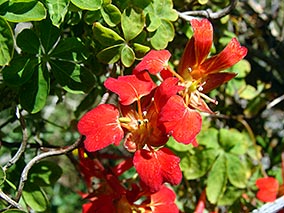Plant pests (weeds) threaten the long-term survival of many of our native birds, lizards, insects and other invertebrate. Weeds can change or destroy their habitat, reducing the availability of food or breeding sites. Over 75% of the weeds of conservation were originally deliberately introduced to NZ as garden plants. Weeds are a serious problem for forest remnants and remnant restoration projects in Southland. Find out more about weeds in Southland and tips for control.
Weeds in New Zealand
 Elderberry - a small deciduous tree.There are about 300 weeds in New Zealand that cause damage to conservation areas. There are over 24,700 introduced plants growing in gardens and nurseries in New Zealand; 10% of these will naturalise (establish in the wild), and 10% of these will become serious pests. Fortunately, many of the ‘World’s Worst Weeds’ are not yet present in NZ.
Elderberry - a small deciduous tree.There are about 300 weeds in New Zealand that cause damage to conservation areas. There are over 24,700 introduced plants growing in gardens and nurseries in New Zealand; 10% of these will naturalise (establish in the wild), and 10% of these will become serious pests. Fortunately, many of the ‘World’s Worst Weeds’ are not yet present in NZ.
Help stop weeds spread
New weed seeds come into New Zealand on imported fresh fruit, used cars, used car tyres, boots, camping equipment, and in soil on and around containers. You can help prevent the spread of weeds by:
- Always stick to designated tracks when walking, horse riding, driving, riding pushbikes or motorbikes through natural areas.
- Disposing of weed waste properly (see tips below).
- Never dumping garden waste – no matter how harmless it seems!
- Choosing non-invasive garden plants for your place.
Weeds in Southland

- Darwin’s Barberry – evergreen shrub
- Broom and gorse – evergreen shrubs
- Chilean flame creeper – perennial vine that dies back in winter
- Elderberry – small deciduous tree
- Gunnera (on Stewart Island) – giant perennial herb
- Holly – evergreen tree with spiny leaves
- Nodding thistle – large thistle that invades open areas
- Old man’s beard – creeping vine that smothers other plants
- Ragwort – herbaceous pasture weed
- Rough horsetail – rushlike, invades waterways and damp areas
- Sycamore – large, deciduous tree.
See Environment Southland’s factsheets for more information about each, including tips on control.
Tips for controlling weeds
- Find out what weeds you’re dealing with first. Ask for expert help.
- Start small. Avoid creating large cleared areas which often allow new and different weeds to establish.
- Plan your control and work in stages. Tackle outlying weed patches first to slow the rate of weed spread before starting on the worst areas. Replace weeds with natives or non-weedy plants as you go. See Southland’s Plant Me Instead guide for more information.
- If your weeds need chemical control, contact Weedbusters Near You to find out the best herbicide to use and how to apply it. You may need permission or qualifications to use herbicide on public land.
- Destroy weeds before they fruit or seed to prevent a new generation of weeds growing inside your work area.
- When shifting dead weeds take care not to spread any seeds or fragments around that could grow again.
- Decide on the best disposal method to use before you start, particularly if working in a large area.
Check out Weedbusters for more information.
Disposing of weeds
Weeds are expert survivors. Many of them can regrow from small fragments of root or stem. New infestations can easily sprout from dumped weed waste that has not been disposed of properly.
When clearing a large area, make sure you know how you’re going to dispose of the weed waste before you start. Look at the weeds you’ve got and how they grow and spread. This will determine what disposal method will work best. Check out Weedbusters for information about disposing:
- Weeds that grow from fragments (e.g. vines and ground covers such as tradescantia).
- Weeds with enlarged, fleshy underground stems i.e. tubers or corms (e.g. Chilean flame creeper).
- Weeds that have lots of seeds, berries and/or persistent roots (e.g. old man’s beard).
For many weeds the best thing may be to dispose of the weed waste at your local approved landfill. Contact your local council or Department of Conservation office if you’re still unsure what to do with your weed waste.
Find out more
Check out the following for useful information:
- Weedbusters – a weeds awareness and education programme that aims to protect New Zealand’s environment from the increasing weed problem.
- Environment Southland – Southland’s Regional Council, a statutory body responsible for managing our natural and physical resources of air, land, water and coast.
